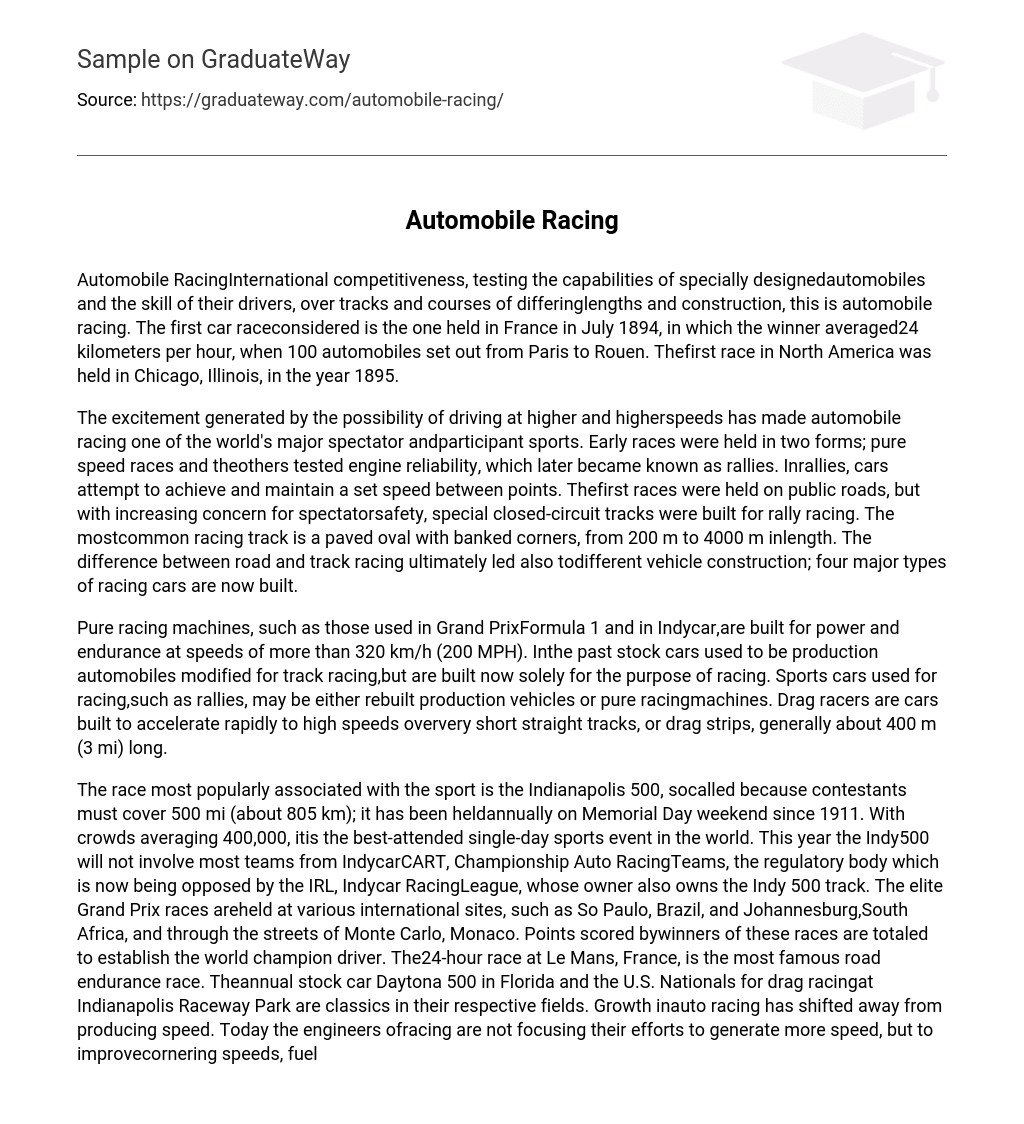Automobile RacingInternational competitiveness, testing the capabilities of specially designedautomobiles and the skill of their drivers, over tracks and courses of differinglengths and construction, this is automobile racing. The first car raceconsidered is the one held in France in July 1894, in which the winner averaged24 kilometers per hour, when 100 automobiles set out from Paris to Rouen. Thefirst race in North America was held in Chicago, Illinois, in the year 1895.
The excitement generated by the possibility of driving at higher and higherspeeds has made automobile racing one of the world’s major spectator andparticipant sports. Early races were held in two forms; pure speed races and theothers tested engine reliability, which later became known as rallies. Inrallies, cars attempt to achieve and maintain a set speed between points. Thefirst races were held on public roads, but with increasing concern for spectatorsafety, special closed-circuit tracks were built for rally racing. The mostcommon racing track is a paved oval with banked corners, from 200 m to 4000 m inlength. The difference between road and track racing ultimately led also todifferent vehicle construction; four major types of racing cars are now built.
Pure racing machines, such as those used in Grand PrixFormula 1 and in Indycar,are built for power and endurance at speeds of more than 320 km/h (200 MPH). Inthe past stock cars used to be production automobiles modified for track racing,but are built now solely for the purpose of racing. Sports cars used for racing,such as rallies, may be either rebuilt production vehicles or pure racingmachines. Drag racers are cars built to accelerate rapidly to high speeds oververy short straight tracks, or drag strips, generally about 400 m (3 mi) long.
The race most popularly associated with the sport is the Indianapolis 500, socalled because contestants must cover 500 mi (about 805 km); it has been heldannually on Memorial Day weekend since 1911. With crowds averaging 400,000, itis the best-attended single-day sports event in the world. This year the Indy500 will not involve most teams from IndycarCART, Championship Auto RacingTeams, the regulatory body which is now being opposed by the IRL, Indycar RacingLeague, whose owner also owns the Indy 500 track. The elite Grand Prix races areheld at various international sites, such as So Paulo, Brazil, and Johannesburg,South Africa, and through the streets of Monte Carlo, Monaco. Points scored bywinners of these races are totaled to establish the world champion driver. The24-hour race at Le Mans, France, is the most famous road endurance race. Theannual stock car Daytona 500 in Florida and the U.S. Nationals for drag racingat Indianapolis Raceway Park are classics in their respective fields. Growth inauto racing has shifted away from producing speed. Today the engineers ofracing are not focusing their efforts to generate more speed, but to improvecornering speeds, fuel economy and the braking of the their creations. Straightaway speeds have not risen significantly since the 1960’s. In spite of this,racing cars have shaved seconds off previous track or course records each yeardue to advances in aerodynamics, brakes, tires and chassis design. Wings, whichfirst appeared in the mid-1960’s, were a major development allowing speed toincrease but also allowing the car to be safe for the driver. Wings arebasically airplane wings turned upside down. Instead of lifting, the wingsforce the car down. Today because of the downforce provided by wings, anIndycar can run upside down on the ceiling. Due to the improvement in cardesign which has led to faster speeds, but also several deaths, many racingorganizations are changing rules for the safety of the drivers. Such examplesare NASCAR implementing restrictor plates to slow the cars, Formula 1 changingfrom methanol burning engines to gasoline burning engines, and Indycar addingpop-off valves, which open if engine pressure is to high thus exposing theengine to atmospheric pressure and leading to low power production form theengine. Auto racing advancement and research has also helped the commercialautomobile industry. The majority of the worlds auto makers have one or moreentries in the 24-hours at Le Mans race. This race is chosen because the strainput on the car could equal strain put on a car by an average consumer in a yearor more. This can show the immediate reliability of new or revised components.
The auto makers may test new engines, chassis, or something as simple as headlights. The turbocharger got its start in racing. The turbo uses exhaust gasesto spin a turbine. This then turns a compressor fan that will compress air asit enters the engine. More air is then in the combustion chamber and it is alsounder pressure. When fuel is added and the mixture is ignited, the compressedair will provide more power than an uncompressed combustion.
As time has passed safety of the car has followed directly behind improvementsin performance of racing cars. Race tracks and courses are lined with safetybarriers to stop a car if it gets off the track out of control. Drivers wearflame retardant clothing from head to toe, even undergarments must be flameretardant. The bodies of the cars are made to fall to pieces on contact. Thisis better than the car remaining in one piece because more of the force ofimpact is absorbed by the car and not the driver. The hardest known material isused to make the chassis and body, carbon, but in a form called carbon fiber.
This is safe because parts of the car are less likely to break off from the car.
These pieces are a great hazard to all drivers who are on track at the same time.
As the popularity of automobile racing continues to rise, the quality of allpeople involved in racing will follow suit. Developments and competition inrecent years have led to revolution in the racing world as competing leaguesstrive to become the world’s racing authority. The technology in racing becomesupdated and remodeled each year which will ultimately see its way into theconsumer world.
Miscellaneous





